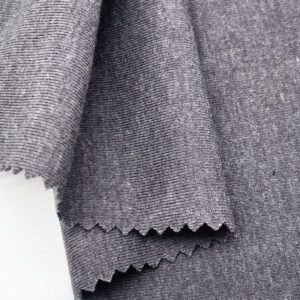Cotton fabric plays several important roles in the manufacturing of curtains and draperies, contributing to both aesthetic appeal and functional performance.
Here are some key roles that cotton fabric plays in this context:
- Softness and Comfort: Cotton fabric is renowned for its soft and comfortable feel, making it an ideal choice for curtains and draperies that come into direct contact with the skin. Cotton curtains add a touch of warmth and coziness to interior spaces, creating a welcoming and inviting atmosphere.
- Breathability: Cotton fabric is highly breathable, allowing air to circulate freely through the fibers. This breathability helps regulate humidity levels in rooms, preventing moisture buildup and reducing the risk of mold or mildew formation behind curtains and draperies. Cotton curtains promote a healthy indoor environment by allowing for proper ventilation and air exchange.
- Light Filtering: Cotton fabric can be woven to various densities and opacities, offering different levels of light filtering and privacy control. Lighter-weight cotton fabrics allow diffused natural light to filter through, creating a soft, gentle glow in the room. Heavier-weight cotton fabrics provide greater opacity and light blocking, offering enhanced privacy and light control.
- Versatility: Cotton fabric comes in a wide range of colors, patterns, and textures, allowing for versatile design options in curtain and drapery manufacturing. Whether seeking a casual, relaxed look or a more formal, elegant aesthetic, designers can find cotton fabrics to suit various decor styles and preferences. Cotton curtains can be tailored to complement the overall design scheme of a room, adding visual interest and character to the space.
- Durability and Longevity: Cotton fabric is known for its durability and longevity, making it a practical choice for curtains and draperies that are subjected to daily use and exposure to sunlight. High-quality cotton fabrics resist fading, shrinking, cotton fabric manufacturers and pilling, maintaining their appearance and performance over time. Cotton curtains are easy to care for and can withstand regular washing, ensuring years of reliable use and enjoyment.
- Eco-Friendliness: Cotton is a natural, renewable fiber derived from the cotton plant, making it an eco-friendly choice for curtains and draperies. Cotton cultivation involves fewer environmental impacts compared to synthetic fibers, such as polyester. Cotton curtains are biodegradable and can be recycled at the end of their lifespan, reducing their environmental footprint.
Overall, cotton fabric plays a crucial role in the manufacturing of curtains and draperies, offering softness, breathability, light filtering, versatility, durability, and eco-friendliness. By choosing cotton curtains, homeowners can enhance the comfort, style, and sustainability of their living spaces while enjoying the many benefits that cotton fabric has to offer.
What are the benefits of using eco-friendly china cotton fabric in sustainable fashion?
Using eco-friendly China cotton fabric in sustainable fashion offers several benefits, aligning with environmental and social responsibility principles. Here are some key advantages:
- Sustainable Sourcing: Eco-friendly China cotton fabric is produced using sustainable farming practices, such as organic cultivation and reduced water consumption. By sourcing cotton fabric from environmentally responsible suppliers, fashion brands can support sustainable agriculture and minimize their ecological footprint.
- Reduced Chemical Use: Eco-friendly China cotton fabric is often cultivated without the use of synthetic pesticides, fertilizers, or genetically modified organisms (GMOs). This reduces the exposure of workers and surrounding ecosystems to harmful chemicals, promoting safer and healthier farming practices.
- Water Conservation: Sustainable cotton farming methods, such as rain-fed agriculture and efficient irrigation techniques, help conserve water resources and reduce the environmental impact of cotton cultivation. By choosing eco-friendly China cotton fabric, fashion brands can support water stewardship initiatives and address water scarcity concerns in cotton-producing regions.
- Lower Carbon Footprint: Eco-friendly China cotton fabric may be produced using renewable energy sources and energy-efficient manufacturing processes, resulting in a lower carbon footprint compared to conventional cotton production. By reducing greenhouse gas emissions and energy consumption, sustainable fashion brands can mitigate climate change impacts and contribute to global sustainability goals.
- Social Responsibility: Eco-friendly China cotton fabric is often sourced from suppliers that prioritize fair labor practices, worker safety, china cotton fabric and social welfare initiatives. By partnering with ethical suppliers, fashion brands can promote social responsibility and support the well-being of cotton farmers and textile workers in China.
- Quality and Performance: Eco-friendly China cotton fabric maintains the same high-quality standards as conventional cotton fabric, offering softness, durability, and breathability. Sustainable cotton fibers are carefully processed and woven to produce fabrics that meet the performance requirements of fashion designers and consumers.
- Consumer Demand: Increasingly, consumers are seeking sustainable and ethically produced fashion products, including clothing made from eco-friendly China cotton fabric. By offering eco-conscious fashion choices, brands can attract environmentally aware consumers and tap into growing market demand for sustainable apparel.
- Circular Economy: Eco-friendly China cotton fabric can be designed for recyclability and biodegradability, supporting circular economy principles in the fashion industry. By incorporating sustainable materials into their collections, fashion brands can reduce textile waste and promote a more circular approach to fashion production and consumption.
Overall, using eco-friendly China cotton fabric in sustainable fashion offers numerous benefits, including sustainable sourcing, reduced chemical use, water conservation, lower carbon footprint, social responsibility, quality and performance, consumer demand, and support for the circular economy. By prioritizing eco-friendly materials and production practices, fashion brands can contribute to a more sustainable and resilient future for the industry.
